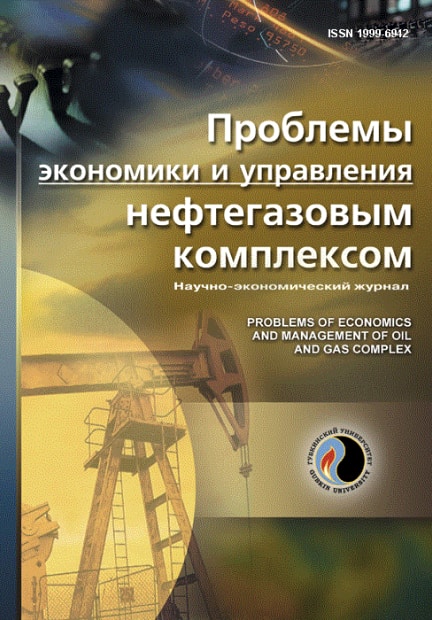Scientific and economic journal
«Problems of economics and management of oil and gas complex»
ISSN 1999-6942

The methodology for construction, optimization and assessment of the change of inter-industry balances "Production – Consumption" in the oil and gas sector
UDC: 338.4
DOI: 10.33285/1999-6942-2023-3(219)-51-59
Authors:
1 Center for System Analysis and Strategic Studies of the National Academy of Sciences of the Republic of Belarus, Minsk, Belarus
2 Russian Academy of Foreign Trade under the Ministry of Economic Development of the Russian Federation, Moscow, Russia
Keywords: sustainable development goals, system of national accounts, oil and gas sector, ESG investment, dynamic standard method, final integral result
Annotation:
Today, it is more than ever important to determine the methodological basis and tools for assessing the effects of changes in individual industries on the economy as a whole and vice versa. Modern methods that are most often applied to determine the criterion of the economy optimal functioning are inflexible and do not allow an iterative process of optimizing the economy, replacing it by static data based on which a forecast is made. Such methods include, firstly, the system of national accounts. The oil and gas sector, being one of the key sectors in the economy of Russia and Belarus, is no exception. In order to more accurately determine the effects of this sector components changes on the economy of the Union State and within the framework of the study, a model for assessing changes in the inter–industry balance "Production – Consumption" has been developed, which allows optimizing the efficiency of the oil and gas sector as a whole. When developing the model, current trends in the field of ESG, the implementation of UN SDG-12 and the current macroeconomic environment are considered. The key results of the study include proving of the significant effect of using the model (up to 3 % of GDP for the Union State) as well as proving the right choice of growth points (the oil and gas sector is one of such points) allows stabilization of the economy as a whole and within one industry to remove imbalances and harmonize the production chain from raw materials to the finished product in terms of volume and time of release. At the same time, the public utility of such optimization is non-zero and consumption is also harmonized, while the disposable income of the population increases, environmental and social development agendas are fulfilled.
Bibliography:
1. Engdahl F.W. The Great Reset is Here: Follow the Money. – URL: https://journal-neo.org/2021/03/19/the-great-reset-is-here-follow-the-money/ (data obrashcheniya 28.04.2021).2. A blueprint for responsible investment. – URL: https://www.unpri.org/pri/a-blueprint-for-responsible-investment/ (data obrashcheniya 28.04.2021).
3. Doklad o chelovecheskom razvitii v Rossiyskoy Federatsii. Tseli ustoychivogo razvitiya. OON i Rossiya / pod red. S.N. Bobyleva, L.M. Grigor'eva. – Analit. tsentr pri Pravitel'stve Rossiyskoy Federatsii, 2016. – 298 s. – URL: https://ac.gov.ru/files/publication/a/11068.pdf (data obrashcheniya 28.04.2021).
4. Net Zero by 2050. A Roadmap for the Global Energy Sector. – IEA, 2021. – 223 p. – URL: https://www.iea.org/reports/net-zero-by-2050/ (data obrashcheniya 28.05.2021).
5. Turko V., Korshunov A. Analiz innovatsionnogo razvitiya metodom dinamicheskogo normativa // Nauka i innovatsii. – 2019. – № 3(193). – S. 31–37.
6. Katyukha P.B. Aktual'nye voprosy transformatsii sistemy tsenoobrazovaniya na neft' v usloviyakh narastaniya neopredelennosti na mirovom rynke energoresursov // Problemy ekonomiki i upravleniya neftegazovym kompleksom. – 2022. – № 12(216). – S. 5–13. – DOI: 10.33285/1999-6942-2022-12(216)-5-13
7. Doklad o vsemirnom razvitii "Tsifrovye dividendy". – Mezhdunarodnyy bank rekonstruktsii i razvitiya, 2016. – IX, 46 s. – URL: http://documents.worldbank.org/curated/en/224721467988878739/pdf/102724-WDR-WDR2016Overview-RUSSIAN-WebRes-Box-394840B-OUO-9.pdf (data obrashcheniya 28.04.2021).
8. Glushkov V.M., Valakh V.Ya. Chto takoe OGAS? – M.: Nauka, 1981. – 160 s. – URL: http://www.pseudology.org/science/Glushkov_OGAS.pdf (data obrashcheniya 28.04.2021).
9. Nauchnyy prognoz ekonomicheskogo razvitiya Respubliki Belarus' do 2030 goda / V.G. Gusakov, A.E. Dayneko, S.M. Dedkov [i dr.]; pod red. akad. V.G. Gusakova. – Minsk: Belaruskaya navuka, 2015. – 244 s.
10. Makarov V.L. Vychislimaya model' rossiyskoy ekonomiki (RUSEC). – M.: TsEMI RAN, 1999. – Preprint # WP/99/069.
11. Karganov S.A. Metodologiya postroeniya, optimizatsii i otsenki izmeneniy mezhotraslevykh balansov "Proizvodstvo-Potreblenie". – 2007. – URL: http://karganov.am.szczecin.pl/Str_Ru.htm (data obrashcheniya 08.11.2017).
12. Karganov S.A. Ob oshibochnosti ispol'zovaniya v narodnokhozyaystvennom planirovanii ekonomiko-matematicheskoy modeli V. Leont'eva i mezhotraslevykh balansov "Zatraty – Vypusk". – URL: http://www.aup.ru/articles/economics/12.htm#_ftn1 (data obrashcheniya 08.11.2017).
13. Asanovich V.Ya., Kasperovich S.A. Analiz ekonomicheskikh protsessov v Respublike Belarus' s pomoshch'yu dinamicheskogo modelirovaniya // Bukhgalterskiy uchet i analiz. – 1999. – № 1(25). – S. 30–33.